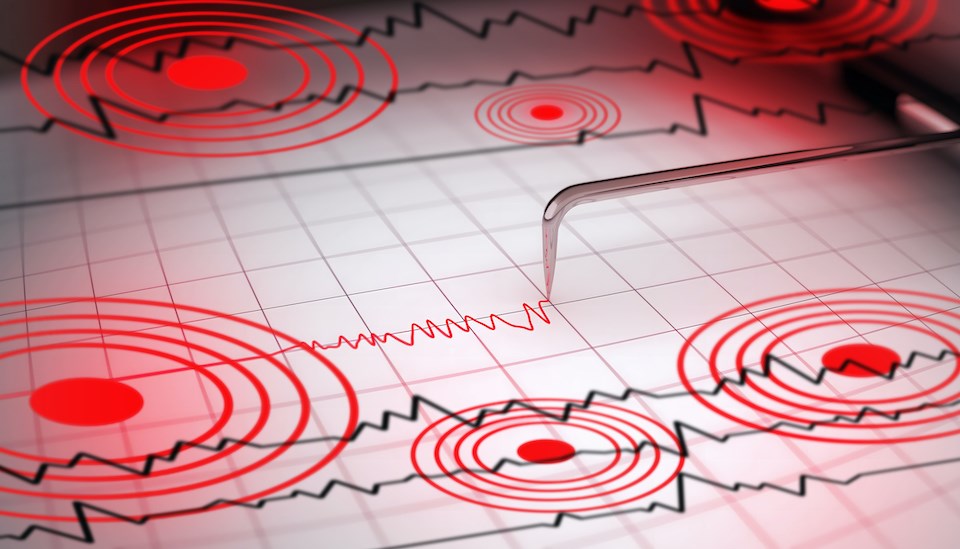Metro Vancouver residents felt an earthquake in the wee hours of Friday, Oct. 4, raising concerns about the possibility of another, possibly larger tremor in the near future.
The quake, which hit just after 2 a.m., had a magnitude of 3.5, according to Earthquakes Canada, and was centred about 18 kilometres west of Delta and east of Ladysmith, B.C. at a depth of 65 kilometres.
Just over a week ago, a 3.8-magnitude shaker in Haro Strait was recorded about 4 a.m. on Sept. 26. That earthquake, centred 11 kilometres east of Sidney and almost 55 kilometres beneath Earth’s surface, was felt by hundreds of people as far north as Nanaimo and Parksville on Vancouver Island and south to Washington state.
Simon Fraser University (SFU) Professor Emeritus John Clague says earthquakes of lower magnitudes occur daily in B.C., although most register under a magnitude of 1 and aren't felt by people.
However, the location of the last two earthquakes raises an interesting concern for experts in the field.
"We've known for quite some time that these earthquakes occur beneath Puget Sound and we know that we get some beneath the Canadian border," the earth sciences expert tells V.I.A.
"The United States Geological Survey (USGS) shows the earthquake site epicentre is close to the border. It tells us that these slab earthquakes can occur beneath the Strait of Georgia but it's getting close to Vancouver."
Clague says the proximity of the last couple of quakes to the Lower Mainland shows a potential for an earthquake closer to home.
"Maybe we could get an earthquake in Vancouver," he says. "The band of earthquakes can extend up."
Magnitude 3 or 4 shakers don't typically cause damage but magnitude 5 ones can cause damage close to the epicentre. A deep, magnitude 5.4 tremor beneath Pender Island in 1975 caused high-rises in Vancouver to sway.
Could recent quakes mean the Big One is coming?
Any mention of the Big One is enough to send shivers down a local's spine without any of the earth's plates sliding. The apocalyptic event will occur but it is impossible to ascertain its timing. Instead, a more likely scenario is a significant, albeit smaller, quake in Metro Vancouver.
"It doesn't mean that we are approaching a magnitude 7 or higher earthquake...it could be little bitty adjustments along the plate boundary. It is interesting that we had two there, though," he remarks on the region's recent seismic activity.
Clague says the Big One involves "a much larger slip" of a few hundred kilometres between the Juan de Fuca Plate and the North American Plate in the Cascadia subduction zone. The magnitude 8 or 9 earthquake would devastate Vancouver Island and the Lower Mainland. Thankfully, this kind of event only occurs every 400 or 500 years.
A more like scenario will see a smaller slip along a "fault on the Juan de Fuca Plate or a small patch on the crust," he notes. A magnitude 5 quake could cause significant damage in Metro Vancouver.
Increased activity in this area could mean a smaller earthquake can occur but it doesn't mean it will. Three factors would determine its impact locally if it does.
- Magnitude: A quake with a higher magnitude causes more damage because it releases more energy.
- Source or epicentre: Tremors under a city or closer to land are more likely to cause damage.
- Depth: All earthquakes occur within the crust of the Earth. Shallow ones typically have more impact on cities.
Clague says large and shallow tremors close to cities are the most damaging.
Are earthquakes more likely to occur at night?
Earthquakes occur at any time of the day and are less likely to be reported if they occur at night, particularly if they aren't strong. The last two shakers felt by locals were in the middle of the night and under a magnitude of 4.
"It wouldn't feel like many people felt an earthquake. Small earthquakes don't have the long, kind of ground motion that a big one does," he notes. "If you're awake it might feel like someone hit the side of your chair."
The most recent tremor was also quite deep, meaning by the time the "energy moves to the Earth's surface and people feel it is pretty diminished."
Clague says the earthquake on Sept. 26 was more widely felt because it was bigger and more shallow. However, both events are important and not trivial since they are "felt" earthquakes.
"We live in earthquake country and get something small daily in B.C. but when you get in mag 3 or higher there is a potential for people to feel them."
The earth sciences expert says deep earthquakes on the Juan de Fuca Plate and beneath the North American Plate and the boundary between them are common and typically occur deep down around 40 to 60 km. Occasionally, shallow tremors within the brittle North American crust occur.
"We can't do anything about it...Mother Nature's game plan involves that collision of one plate against the other that can lead to periodic fracturing of the crust and movements along faults."
With files from the Times Colonist.



